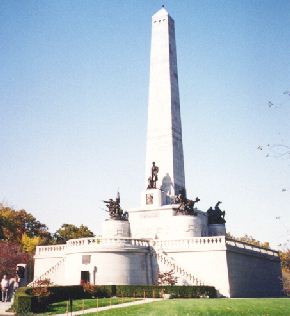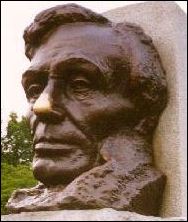Home | News | Books | Speeches | Places | Resources | Education | Timelines | Index | Search
© Abraham Lincoln OnlineLincoln Tomb State Historic Site
Oak Ridge Cemetery
Springfield, IllinoisSPECIAL EVENTS
February 12 Wreath-Laying Ceremony
April 15 Death Day Ceremony
June - August Tuesdays at 7 p.m. Flag-Lowering Ceremony by the 114th Infantry Regiment Illinois Volunteers ReactivatedLincoln's 1865 Springfield Funeral Reenactment
Shortly after President Lincoln's assassination, Henry Ward Beecher, famous pastor of Plymouth Church, Brooklyn, New York, paid a tribute which speaks prophetically of this historic Lincoln site:
"Four year ago, O Illinois, we took from your midst an untried man and from among the people. We return him to you a mighty conquerer. Not thine any more, but the nation's; not ours, but the world's. Give him place, O ye prairies. In the midst of this great continent his dust shall rest, a sacred treasure to myriads who shall pilgrim to that shrine to kindle anew their zeal and patriotism."A similar sentiment was voiced by Dr. Phineas D. Gurley, pastor of the New York Avenue Presbyterian Church in Washington, DC. Gurley, who ministered to the Lincoln family during the presidential years, and mentioned the Lincoln tomb during his funeral sermon at the White House on April 19, 1865:
"that grave will be a precious and a consecrated spot. The friends of Liberty and of the Union will repair to it in years and ages to come, to pronounce the memory of its occupant blessed, and, gathering from his very ashes, and from the rehearsal of his deeds and virtues, fresh incentives to patriotism, they will there renew their vows of fidelity to their country and their God."Oak Ridge Cemetery was dedicated on May 24, 1860, five years before Lincoln's assassination, just outside the town where Lincoln lived most of his adult life. It is likely that he attended the ceremonies and heard his friend James Conkling deliver the main address.
After Lincoln's death on April 15, 1865, his Illinois friends immediately sought permission to bury him in Springfield. The committee which arranged his Springfield funeral also formed an association to build this tomb, which was dedicated in 1874. In 1895 the association deeded the tomb and surrounding grounds to the State of Illinois.
Lincoln's body first arrived in the cemetery's public receiving vault on the hill behind and below the present tomb. The coffin of his son William, who died in the White House at age 11, also rested there. Both had traveled nearly 1,700 miles in a special railroad car by a circuitous route from Washington, D.C. before burial on May 4, 1865.
The 117-foot tall granite tomb contains the bodies of Lincoln, his wife Mary, and three of his four sons -- Edward, William and Thomas (Tad). Robert, the eldest son, planned to be buried in this tomb with his parents and brothers. When his own son, Abraham Lincoln II ("Jack") died at age 16 in 1890, he brought the body to the Lincoln tomb. However, after his death his wife, Mary Harlan Lincoln chose a gravesite in Arlington National Cemetery instead, where Robert was buried in 1928 and Jack was moved in 1930.
Like other Lincoln sites, the tomb attracts visitors from all over the world, some of whom bring floral tributes. As you drive up, you will see towering oak trees against a gently rolling landscape. Robert Todd Lincoln, the president's son, and Supreme Court Associate Justice David Davis, a close friend, selected the tomb's site on May 5, 1865.
A red granite marker stands over the area where Lincoln's coffin lies, a substitute for the original white marble sarcophagus. His body actually rests below the floor in a steel and concrete-reinforced vault. This change was made in 1901 when the monument needed reconstruction, partly to deter grave robbers, because an attempt on the body had been made in 1876.
© Abraham Lincoln Online
Designed by New Hampshire-born sculptor Larkin G. Mead, the tomb features famous Lincoln statuary. It's worth a visit just to see the sculpture, both inside and out. Visitors often stop to rub the nose of this evocative bronze bust at the entrance. This is the work of Gutzon Borglum, whose most famous rendition of Lincoln can be found at Mount Rushmore. You will find the original marble bust in the the U.S. Capitol in Washington, D.C. As you enter the building, you will see bronze statues of Lincoln depicting various aspects of his life and excerpts from some of his most famous speeches. A circular hallway leads to the marble burial chamber where Secretary of War Edwin Stanton's famous words command your attention: "Now he belongs to the ages." The terrible human cost of the Civil War has an immediacy here, as if Lincoln died yesterday.
Visiting Information
The Lincoln Tomb State Historic Site is open free of charge daily from 9:00 a.m. to 5:00 p.m.It is closed on major holidays. If you visit at 7:00 p.m. on Tuesdays from June through August, you can see a flag-lowering ceremony enacted by volunteers in Civil War uniforms. The tomb's interior and restrooms are handicapped accessible. Groups of 25 or more should make reservations. Call 217/782-2717 or write: Site Manager, Lincoln Tomb State Historic Site, Oak Ridge Cemetery, Springfield, IL 62702.
Click Here for Related Web Sites
Related Reading
Davenport, Don. In Lincoln's Footsteps: A Historical Guide to the Lincoln Sites in Illinois, Indiana, & Kentucky. Madison: Prairie Oak Press, 1991.
Hanchett, William. The Lincoln Murder Conspiracies. Urbana: University of Illinois Press, 1989.
Kunhardt, Dorothy Meserve and Philip B. Kunhardt, Jr. Twenty Days. New York: Harper & Row, 1965.
Lewis, Lloyd. The Assassination of Abraham Lincoln: History and Myth. University of Nebraska Press, 1994.
Newman, Ralph. "In This Sad World of Ours, Sorrow Comes to Us All:" A Timetable for the Lincoln Funeral Train. Springfield: Journal of the Illinois State Historical Society, Spring 1965.
Speer, Bonnie Stahlman. The Great Abraham Lincoln Hijack. Reliance Press, 1990.
Home | News | Education | Timelines | Places | Resources | Books | Speeches | Index | Search Text and photos © 2018 Abraham Lincoln Online. All rights reserved. Privacy Policy


